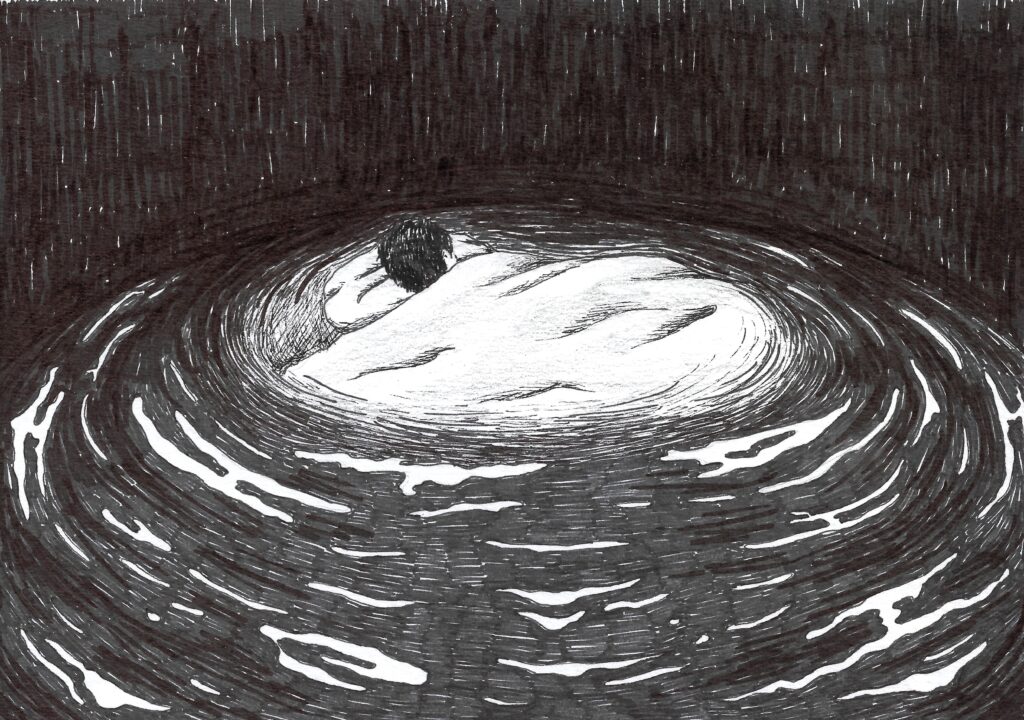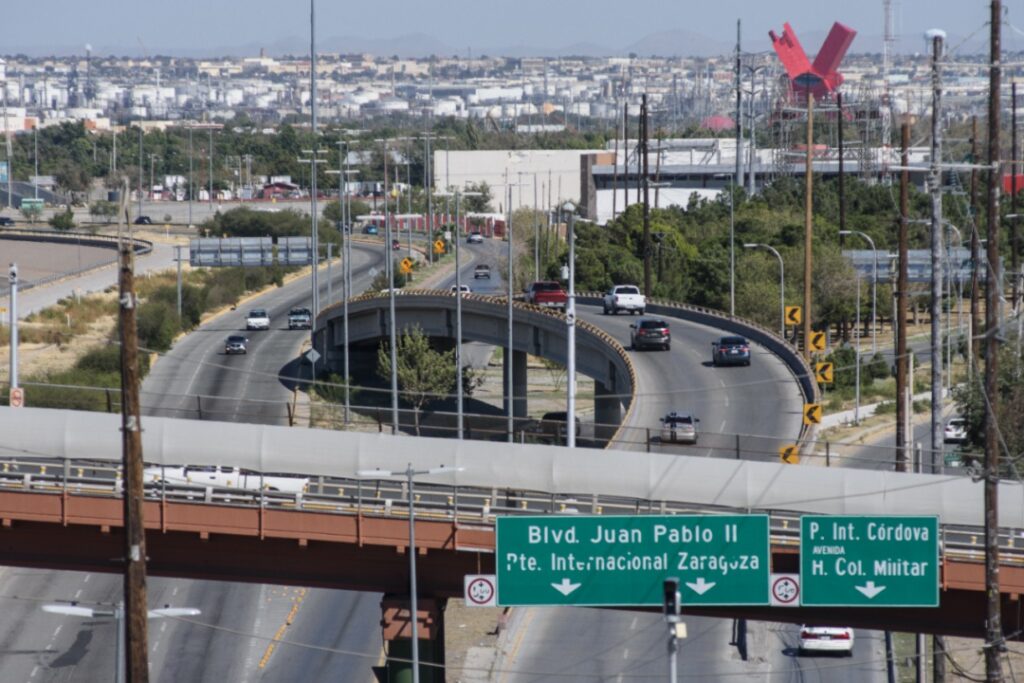POR VERÓNICA MARTÍNEZ / LA VERDAD Y ELIDA S. PÉREZ / EL PASO MATTERS
Part 1 of 2 Leer en español aquí
The borderland’s traumas caused by drug violence are being triggered by rising stress, anxiety, depression, and PTSD brought on by the COVID-19 pandemic.
His illness was like a pendulum — swinging from one end to another — during the COVID-19 pandemic lockdowns.
Making matters worse, the free psychological care he used to receive at the University of Texas at El Paso’s Counseling and Psychological Services Center as a student ended when he graduated in May 2020. Then the master’s program in which he planned to enroll was canceled, leaving him without access to the mental health care he’d come to rely on.
“It was really unfortunate because it happened just as the pandemic was starting and we were in the middle of the strictest lockdown,” Jorge said.
Jorge also went 10 months without a job, and even after finding work and health benefits, has found it difficult to find a therapist covered by his insurance.
“I definitely felt like my therapy was still a work in progress. And as time went by, my mental health was getting worse because I didn’t have that kind of support anymore.”
Puente News Collaborative doesn’t identify people suffering from mental health conditions who are not comfortable having their full names published.
You’re Not Alone
People across the globe — including thousands of El Pasoans and Juarenses like Jorge — were left facing mental health struggles after the World Health Organization declared the spread of the COVID-19 virus a pandemic in March 2020.
Health experts on both sides of the U.S.-Mexico border have seen a rise in demand for mental health services since the pandemic started.
In fact, global prevalence of anxiety and depression increased 25% in the first year of the pandemic, according to a scientific brief released by the WHO this spring.
In the United States, 4 in 10 adults reported symptoms of anxiety or depressive disorder during the pandemic compared to 1 in 10 in 2019, according to a February 2021 report by the Kaiser Family Foundation, a nonprofit organization focusing on national health issues.
In Texas, 29.5% of adults reported symptoms of anxiety disorder during the pandemic, 25.9% reported depressive disorder symptoms and 34.5% reported anxiety or depressive disorder symptoms. That compares to the 11% of adults who reported symptoms of anxiety and/or depressive disorder from January to June 2019, according to the report.
Just as concerning, medical experts also attribute an increase in substance abuse, domestic violence, child abuse — and, cautiously, in suicides — in large part to the numerous stressors the pandemic has created.
Calling Out for Help
In 2021, 48% of people receiving mental health services in Ciudad Juárez experienced mild symptoms of depression and 39% experienced severe symptoms at least once a week, according to data gathered by the network of health care organizations known by its Spanish acronym as ROTMENAS (Network of Organizations Dedicated to Prevention and Treatment of Neurological and Mental Disorders and Substance Abuse).
The organization reports that 49% of the people surveyed experienced a panic attack in the past year.
In El Paso County, some 140,000 adults had either mild, moderate or severe mental health needs prior to the pandemic in 2019, according to data collected by the Paso del Norte Center at the Meadows Mental Health Policy Institute. Of those, about 25,000 had severe mental health conditions.
The most common diagnosis in El Paso was major depression, which affected 45,000 adults, data shows. Post-traumatic stress disorder affected 20,000 adults.
Launched in 2021, the nonprofit institute conducted the El Paso Behavioral Health Assessment and aims to improve mental health systems, share best practices, develop resources and increase public awareness on effective ways to treat mental illness.
Officials with the Meadows Institute said data for 2020 and 2021 has not been finalized.

Complex Traumas: Drugs, Violence, Crises
Health care providers say that the pandemic merely added to an already increasing caseload as El Paso and Juárez had already been dealing with a number of crises.
When the pandemic hit, El Paso was still recovering from the Aug. 3, 2019, terrorist shooting at the Cielo Vista Walmart that killed 23 people. Adding to the community’s stress was the humanitarian crisis in 2018-19, when tens of thousands of Central American migrants crossed the border in hopes of seeking asylum, as then-President Trump implemented a family separation policy.
“Before the pandemic started, we had just gotten past the August 3 shooting and the community was not at its best point mental health wise,” said Dr. Fabrizzio Delgado, division chief for the psychiatry consult service at Texas Tech Physicians of El Paso.
Delgado said the pandemic turned the healthcare system upside down at a time when there was already a shortage of services in the community.
There have been fluctuations in the demand for care since the pandemic began, Delgado said, in part due to stay-at-home orders imposed during the pandemic’s peak. People were initially avoiding hospitals for fear of contracting the virus.
Once the orders were lifted, a wave of patients who had attempted suicide sought care in emergency rooms across the city, he said, and there was also a rise in the number of patients who were abusing alcohol and opioids.
Now in the pandemic’s third year, Delgado said he is seeing people with mood disorders such as anxiety and depression. Alcohol and opioid abuse continue on the upswing, he said.
“(That’s) the biggest problem now,” Delgado said. “(And) that’s probably because of all of the isolation, lack of work and a lot of financial problems and a lot of stress.
Celeste Nevarez, chief of clinical services at Emergence Health Network, said there has been a shift in the types of mental health conditions over the last few years.
“Coming off Aug. 3, we were just so scared as a community, but we were also OK with being scared, if that makes sense — we normalized it,” Nevarez said. At the time, she added, El Pasoans reached out for help coping with anxiety and stress.
The largest mental health provider in El Paso County with 19 service locations, Emergence provides services and treatment for severe or persistent mental illness, intellectual or development disabilities and substance abuse.
The agency served nearly 20,080 patients in 2019, which dipped slightly to about 19,300 in the first year of the pandemic. In 2021, Emergence saw an uptick in patients to about 21,250.
Nevarez said there was also a rise in domestic abuse and child abuse because people were under stresses such as loss of employment, isolation and not being able to leave their homes because of pandemic lockdowns.
Across Texas, family violence incidents in 2020 were at nearly 213,900 — an 8.6% increase from 2019, according to Texas Uniform Crime Reporting. The incidents involved more than 231,000 victims (up 9.2% from 2019) and about 224,800 offenders (up 9% from 2019).

“What I’m seeing now, two years in (to the pandemic) is just this really complex trauma,” Nevarez said, referring to ongoing or repeated interpersonal trauma.
Nevarez said some people hesitate to use the word “trauma” because they associate it with post-traumatic stress disorders typically related to military service.
But trauma is also associated with the immense loss of life, grief, loss of normalcy and hopelessness — the roller coaster of emotions that the pandemic has caused, she said.
That also includes comparing ourselves to others and how they’ve coped in the pandemic, Nevarez added.
“(Some people would say) ‘I learned a new language while I was at home, this is great.’ Or some people were like, ‘Well, I had all that time alone and I didn’t learn a new language, what a waste of time,’” Nevarez said. “So (there’s this) measuring stick that doesn’t exist.”
She said the complex emotions and compound feelings are now bubbling over because everyone thought the pandemic would be resolved and done by now.
Health officials have said COVID-19 will likely not go away completely but are hopeful that cases of the virus will become milder over time as it continues to mutate.
Juárez ‘Battered, Violated’
Juarenses, too, were recovering from the mass shooting in their sister city where some Mexican nationals were also killed. Juárez was also facing stress from the thousands of migrants who were stranded and stuck in the city as they sought to enter the United States.
Add to that the drug wars and violence against women that have long plagued the city, and the mental health of Juarenses has been left battered and vulnerable, said Gustavo Padilla, the planning advisor for ROTMENAS, the network of mental health professionals and providers in Juárez.
“The list of vulnerabilities we have in Ciudad Juárez is long, and this affects people both physically and mentally,” Padilla said. “We have to make it seen that people’s mental health in Juárez has been battered and violated and we have to give this issue as much importance as we give physical health issues.”
Perhaps most impactful has been the loss of life residents in the border cities are having to live through — grieving as they bury loved ones and often not having had the chance to say goodbye, said Oscar Esparza, psychologist and professor at the University of Ciudad Juárez.
More than 8,000 people have died of COVID in the El Paso and Ciudad Juárez region since the pandemic began.
Among them was Luisa’s father, who passed away in June 2020.
As a 28-year-old master’s student living in Juárez with her family, Luisa first grew anxious as she feared her parents might catch the virus — especially since her father wasn’t taking the pandemic seriously, she said.
When her father contracted COVID, she was in a constant state of alarm. She put reminders in her phone to give him his medicine — fearing she wouldn’t do so correctly — and sent frequent updates to her siblings in El Paso. As his symptoms worsened, Luisa’s father was hospitalized.
“I remember that my dad was really mad at me and I think that also affected me because the last time I spoke with him he was very upset,” she said.
He died at the hospital and Luisa was left with the task of dealing with paperwork to bury her father — and informing her siblings and family about his death.
“When they told us that our dad had died, we were still on high alert. I did cry, but immediately I thought, ‘What next?’”
For many like Luisa, the grieving process was complicated. She often felt lonely, and family and friends couldn’t offer comforting hugs as social distancing was still in place.
“Everyone called us but we really couldn’t hug each other. In fact, at the funeral people told us they didn’t know whether to hug us or not. They kept their distance,” Luisa said.

The constant calls were overwhelming, but more difficult was not being able to say goodbye to her father. She didn’t even get to see his body after his death.
“When they told us (he had died) I wondered how I could be sure. You don’t see the body; we never saw it. Not even in the casket. It weighed heavily on my mom that she couldn’t save him,” Luisa said.
Soon after, Luisa started to use an inhaler and was prescribed multiple medicines. She often felt like her throat was tightening and couldn’t breathe.
In a sense of panic, she would constantly cough and feared she might have COVID or long COVID. She later found out these were symptoms of a panic attack. In one instance, she was with her mother at a car repair shop when she gasped for air and felt a deep sensation of drowning.
“I remember thinking, ‘I am really okay,’” she said. “That’s when I thought I had had enough and I didn’t want to live with panic attacks.”
Grieving About More than Death
Depression, anxiety — and grief — don’t only manifest themselves after the death of a loved one.
The death of a routine — of a lifestyle one becomes accustomed to — can also have dire effects on our mental health, said Ana Gutiérrez, psychologist and director of the Center for Psychological Care SURÉ in Ciudad Juárez.
“Individuals are experiencing great instability. Add to that regular fear and stress derived from catching COVID and staying at home, isolated,” Gutiérrez said. “Then situations crop up like mixed-up home and work schedules, schedules that are no longer what they used to be.”
That was the case for Gabriela, 29, a Juárez resident who sought therapy to help her cope with the dramatic changes in her life during the pandemic.
The pandemic was a mixed bag of good and bad for her. It first allowed her to work from home for a museum before she found a job with higher pay. She also took on other projects that tripled her income, including teaching English and editing YouTube videos.
“Even though it sounds terrible, I think the pandemic was really good for me,” Gabriela said. “I have new goals, a new way of life. However, my body tells a very different story.”
Gabriela would often feel her throat tighten and had difficulties breathing. She couldn’t sleep, felt tense all over and was often irritated. She fractured two molars in January. That’s when she found she had bruxism, a condition where people unconsciously grind or clench their teeth – especially when they’re feeling anxiety, stress, anger or frustration.
“The first thing the dentists asked me was, ‘Did anything happen to you during the pandemic? Did you lose someone?’”
She had not lost any friends or relatives to COVID-19, but she had overworked herself. She started therapy in October 2021 and was told she had anxiety.
“I couldn’t take it anymore,” Gabriela said. “I didn’t have any more tolerance for stress at that point.”
Gabriela’s experiences are prime examples of what therapists at SURÉ say is happening across the board as the pandemic destabilized our routines: More people are dealing with depression and anxiety, as well as post-traumatic stress, sleep and eating disorders, burnout syndrome and psychotic breaks.
In 2019, nearly 4,800 physician consultations for mental health related conditions took place at the ambulatory services of the Health Sector II in Juárez, according to data from Chihuahua’s Health Services Department. The number of consultations rose to nearly 5,900 in 2020 and then decreased to 3,630 in 2021.
Data shows that the number of consultations related to anxiety increased by 117% from 2019 to 2020. From 2020 to 2021, consultations went down by 70%. Anxiety disorders remained the primary mental health issue affecting patients in Juárez.
In 2020 and 2021, depression and other stress disorders were the main mental health conditions treated at the state’s health services.
Ending the Pain: Suicide on the Rise
Suicide is perhaps one of the most concerning outcomes of increased depression and other mental health disorders brought on by the pandemic.
Deaths by suicide have been slowly on the rise in El Paso County since 2015, according to data from the Paso del Norte Health Foundation. From 2018 to 2020, there were about 11.6 deaths by suicide per 100,000 people compared to the rate of 9.5 per 100,000 from 2015-17.
Although data from the CDC shows an overall decline in deaths by suicide in 2020 from previous years, experts with the Austin-based Hogg Foundation for Mental Health anticipate those figures may rise because of the pandemic, according to a recent report.
That includes the mental impacts of physical and social distancing, financial hardships and the trauma faced by loved ones of individuals who have died or become critically ill from the virus.
In Juárez, SURÉ, which offers low-cost services for college students and the community, saw a “gradual but constant increase” with cases regarding suicidal thoughts and behavior, its director Ana Gutiérrez said.
“I have seen that each semester sees more mental health requests for depression, but it has now escalated to suicidal thoughts or attempts. This has only increased during the pandemic,” Gutiérrez said.
The state of Chihuahua continues to lead in suicide rates in México with fourteen deaths per 100,000 people.
UACJ’s Esparza said that the increase in suicides cannot be completely blamed on the pandemic since these numbers have been consistently rising since 2015.
Juárez was the municipality that had the highest number of reported cases of suicides between January and September 2020 with 87, followed by the city of Chihuahua with 82.
In 2020, 4.1% of Juarenses considered committing suicide according to the yearly Report of Subjective Wellbeing conducted by the organization Plan Estratégico de Juárez. In 2019, that number was 3.9%. The same report also showed a significant increase in actual suicide attempts, going from 1.9 in 2019 to 2.6 in 2020.
“It’s been an issue that’s gone on for years. That’s why we started this assessment with Plan Estratégico,” Esparza said.
Borderland resident María Fernanda, 21, knows all too well how those feelings of desperation can lead to suicidal thoughts.
She moved to El Paso from Juárez at age 16 to attend school in the United States, which forced her to overcome her mild anxiety and become more extroverted in order to make friends.
But those feelings of anxiety came back ten-fold when the pandemic hit while she was enrolled at UTEP. Added to that were isolation when classes moved online and because of fears of spreading COVID, feelings of guilt and stress — and even death.
“(At first) I couldn’t even grasp the idea of hurting myself,” she said about the thoughts swirling in her head.
“But it became more like, ‘Is death actually something bad or is it going to keep me sane? Or is it going to bring me peace rather than the pain or the fear that a lot of people say it brings?’”
***
This story was produced as part of the Puente News Collaborative, a binational association of news organizations in Ciudad Juárez and El Paso.
















